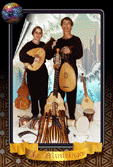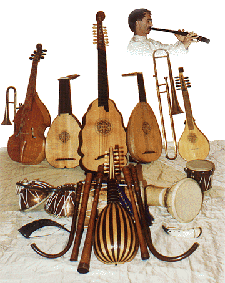|

Click the pic for a large JPEG! (59K)
The MINISINGERS are Hilary Rhodes and Graeme Stentiford who formed their partnership in 1986. They specialise in music from the 12th to the early 17th centuries. Hilary is a soprano and Graeme, tenor and countertenor (male alto). They are multi-instrumentalists and accompany themselves while singing with lute, viol and percussion, and are thus able to perform music in three or four parts, e.g. madrigals and motets. They present a wide variety of sounds and textures with many interesting combinations - e.g. crumhorn, voices and percussion. They perform in many different styles ranging from secular and religious European music of the Middle Ages and Renaissance, to folksong and dance music, singing in Italian, French, German, Spanish, and Chaucerian English.
Here below is a photograph of many of our instruments

Click on the instruments to find out more
about them
Here is a brief description of some of their instruments, many of which are Australasian made.
|